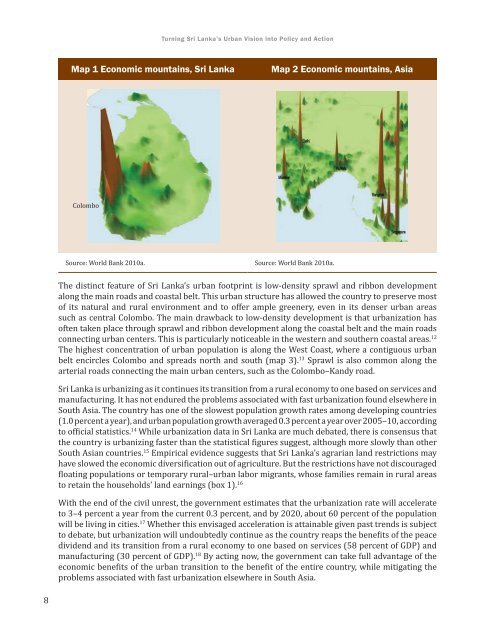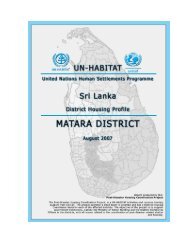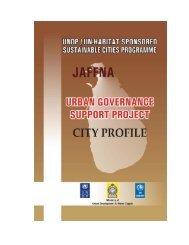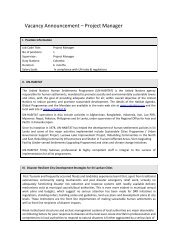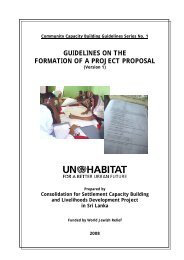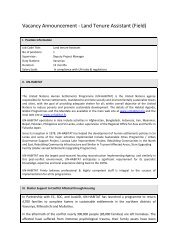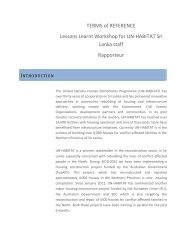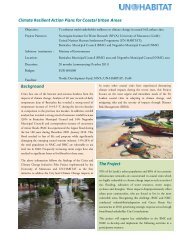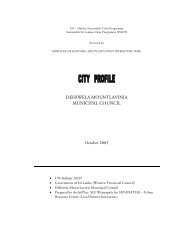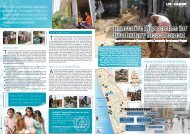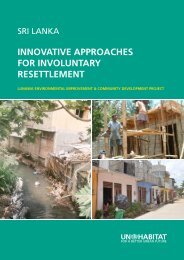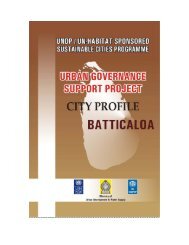Turning Sri Lanka's Urban Vision into Policy and Action - UN HABITAT
Turning Sri Lanka's Urban Vision into Policy and Action - UN HABITAT
Turning Sri Lanka's Urban Vision into Policy and Action - UN HABITAT
You also want an ePaper? Increase the reach of your titles
YUMPU automatically turns print PDFs into web optimized ePapers that Google loves.
<strong>Turning</strong> <strong>Sri</strong> Lanka’s <strong>Urban</strong> <strong>Vision</strong> <strong>into</strong> <strong>Policy</strong> <strong>and</strong> <strong>Action</strong>Map 1 Economic mountains, <strong>Sri</strong> LankaMap 2 Economic mountains, AsiaColomboSource: World Bank 2010a. Source: World Bank 2010a.The distinct feature of <strong>Sri</strong> Lanka’s urban footprint is low-density sprawl <strong>and</strong> ribbon developmentalong the main roads <strong>and</strong> coastal belt. This urban structure has allowed the country to preserve mostof its natural <strong>and</strong> rural environment <strong>and</strong> to offer ample greenery, even in its denser urban areassuch as central Colombo. The main drawback to low-density development is that urbanization hasoften taken place through sprawl <strong>and</strong> ribbon development along the coastal belt <strong>and</strong> the main roadsconnecting urban centers. This is particularly noticeable in the western <strong>and</strong> southern coastal areas. 12The highest concentration of urban population is along the West Coast, where a contiguous urbanbelt encircles Colombo <strong>and</strong> spreads north <strong>and</strong> south (map 3). 13 Sprawl is also common along thearterial roads connecting the main urban centers, such as the Colombo–K<strong>and</strong>y road.<strong>Sri</strong> Lanka is urbanizing as it continues its transition from a rural economy to one based on services <strong>and</strong>manufacturing. It has not endured the problems associated with fast urbanization found elsewhere inSouth Asia. The country has one of the slowest population growth rates among developing countries(1.0 percent a year), <strong>and</strong> urban population growth averaged 0.3 percent a year over 2005–10, accordingto official statistics. 14 While urbanization data in <strong>Sri</strong> Lanka are much debated, there is consensus thatthe country is urbanizing faster than the statistical figures suggest, although more slowly than otherSouth Asian countries. 15 Empirical evidence suggests that <strong>Sri</strong> Lanka’s agrarian l<strong>and</strong> restrictions mayhave slowed the economic diversification out of agriculture. But the restrictions have not discouragedfloating populations or temporary rural–urban labor migrants, whose families remain in rural areasto retain the households’ l<strong>and</strong> earnings (box 1). 16With the end of the civil unrest, the government estimates that the urbanization rate will accelerateto 3–4 percent a year from the current 0.3 percent, <strong>and</strong> by 2020, about 60 percent of the populationwill be living in cities. 17 Whether this envisaged acceleration is attainable given past trends is subjectto debate, but urbanization will undoubtedly continue as the country reaps the benefits of the peacedividend <strong>and</strong> its transition from a rural economy to one based on services (58 percent of GDP) <strong>and</strong>manufacturing (30 percent of GDP). 18 By acting now, the government can take full advantage of theeconomic benefits of the urban transition to the benefit of the entire country, while mitigating theproblems associated with fast urbanization elsewhere in South Asia.8


